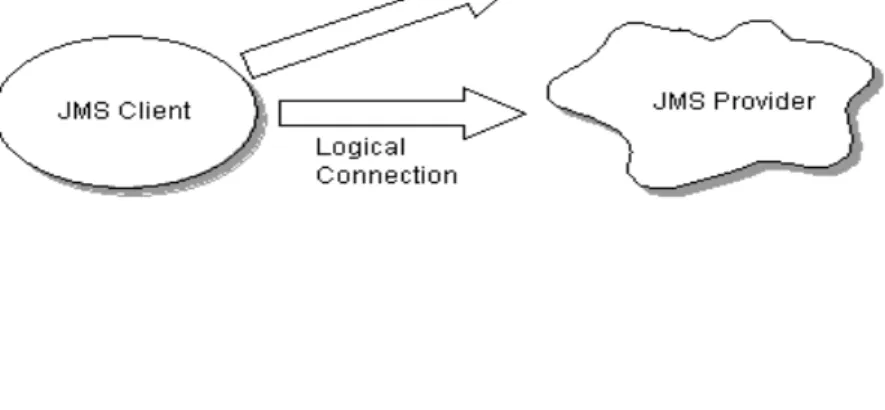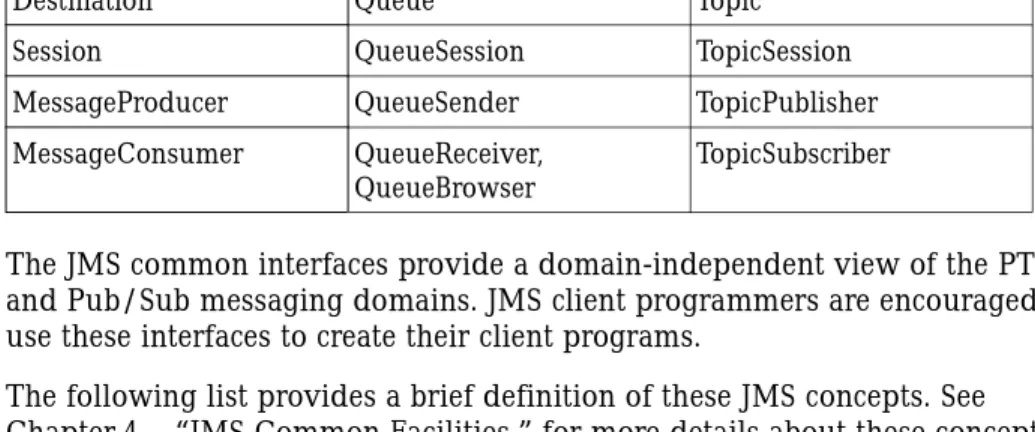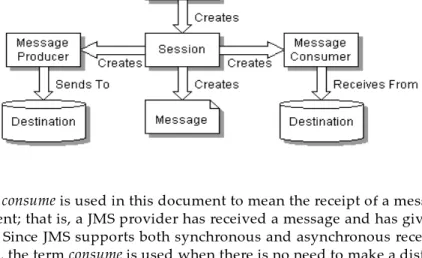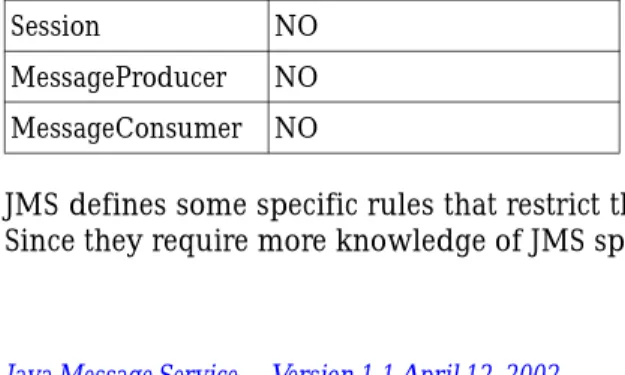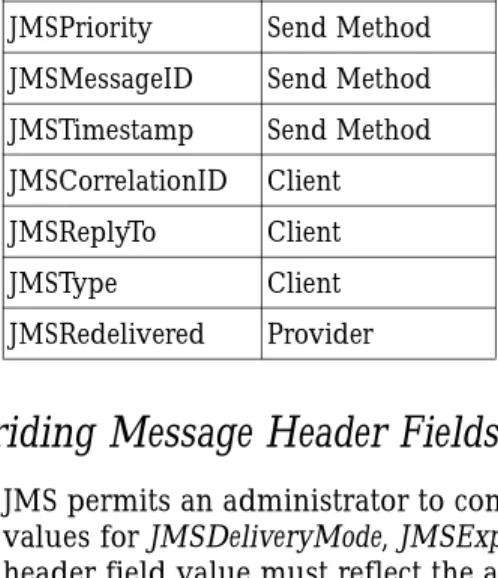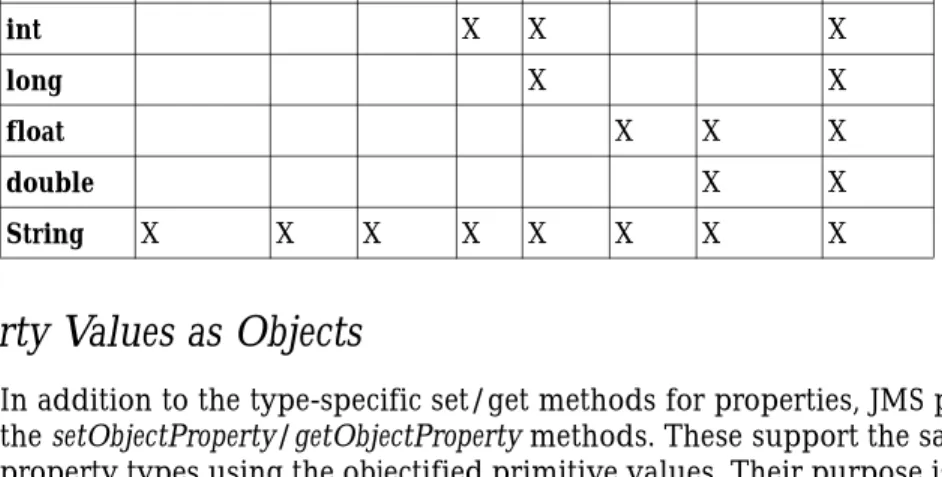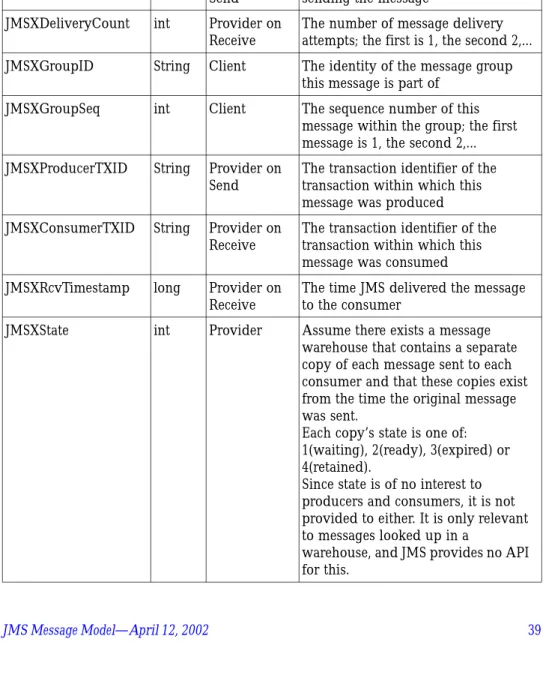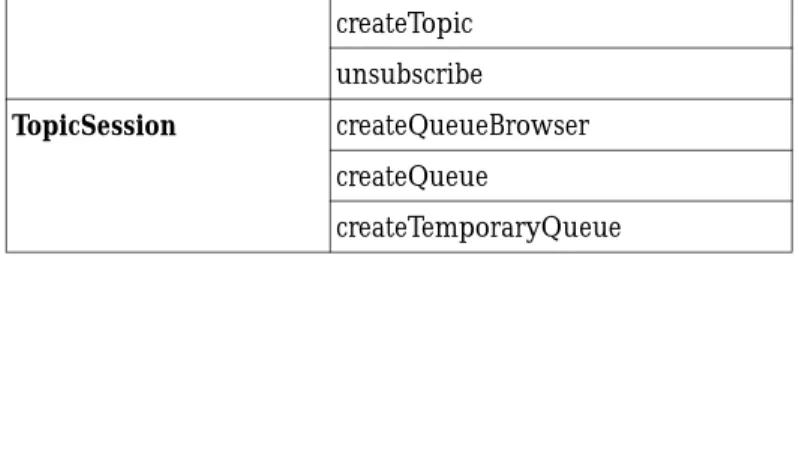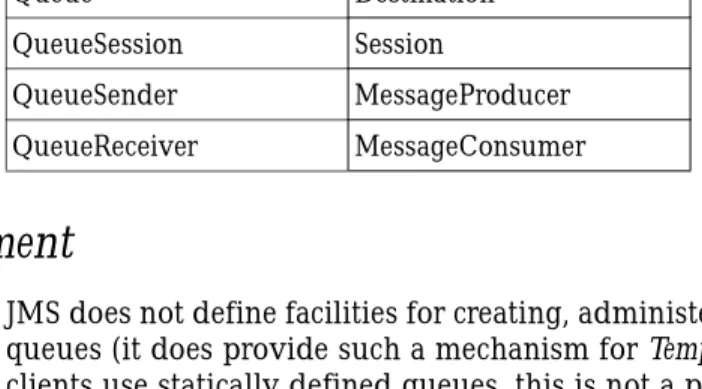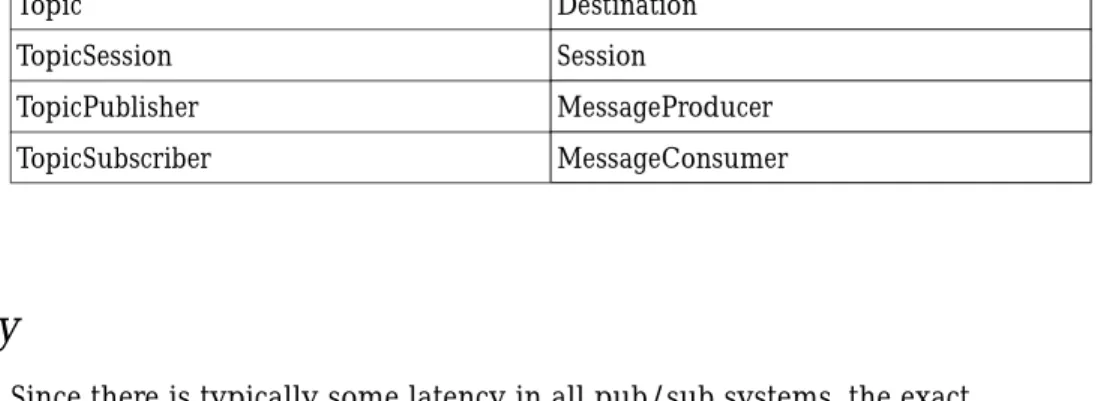901 San Antonio Road Palo Alto, CA 94303 U.S.A.
The JMS API is an API for accessing enterprise messaging systems
from Java programs .
Version 1.1 April 12, 2002
Please send technical comments on this specification to:
jms-comments@sun.com
Please send product and business questions to:
jms-business-comments@sun.com
Mark Hapner, Distinguished Engineer
Rich Burridge, Staff Engineer
Rahul Sharma, Senior Staff Engineer
Joseph Fialli, Senior Staff Engineer
Kate Stout, Senior Staff Engineer
Sun Microsystems, Inc.
Copyright 2002 Sun Microsystems, Inc.
901 San Antonio Road, Palo Alto, California 94303, U.S.A. All rights reserved.
NOTICE
The Specification is protected by copyright and the information described therein may be protected by one or more U.S. patents, foreign patents, or pending applications. Except as provided under the following license, no part of the Specification may be reproduced in any form by any means without the prior written authorization of Sun Microsystems, Inc. ("Sun") and its licensors, if any. Any use of the Specification and the information described therein will be governed by the terms and conditions of this license and the Export Control Guidelines as set forth in the Terms of Use on Sun's website. By viewing, downloading or otherwise copying the Specification, you agree that you have read, understood, and will comply with all of the terms and conditions set forth herein.
Subject to the terms and conditions of this license, Sun hereby grants you a fully-paid, non-exclusive, non-transferable, worldwide, limited license (without the right to sublicense) under Sun's intellectual property rights to review the Specification internally solely for the purpose of designing and developing your Java applets and applications intended to run on the Java platform. Other than this limited license, you acquire no right, title or interest in or to the Specification or any other Sun intellectual property. The Specification contains the proprietary information of Sun and may only be used in accordance with the license terms set forth herein. This license will terminate immediately without notice from Sun if you fail to comply with any provision of this license. Upon termination or expiration of this license, you must cease use of or destroy the Specification.
TRADEMARKS
No right, title, or interest in or to any trademarks, service marks, or trade names of Sun or Sun's licensors is granted hereunder. Sun,Sun Microsystems, the Sun logo, Java, Jini, J2EE, JavaServerPages, Enterprise JavaBeans, JavaCompatible, JDK, JDBC, JavaBeans, JavaMail, Write Once, Run Anywhere, and Java Naming and Directory Interface are trademarks or registered trademarks of Sun Microsystems, Inc. in the U.S. and other countries.
DISCLAIMER OF WARRANTIES
THE SPECIFICATION IS PROVIDED "AS IS". SUN MAKES NO REPRESENTATIONS OR WARRANTIES, EITHER EXPRESS OR IMPLIED, INCLUDING BUT NOT LIMITED TO, WARRANTIES OF MERCHANTABILITY, FITNESS FOR A PARTICULAR PURPOSE, OR NON-INFRINGEMENT THAT THE CONTENTS OF THE SPECIFICATION ARE SUITABLE FOR ANY PURPOSE OR THAT ANY PRACTICE OR IMPLEMENTATION OF SUCH CONTENTS WILL NOT INFRINGE ANY THIRD PARTY PATENTS, COPYRIGHTS, TRADE SECRETS OR OTHER RIGHTS. This document does not represent any commitment to release or implement any portion of the Specification in any product.
THE SPECIFICATION COULD INCLUDE TECHNICAL INACCURACIES OR TYPOGRAPHICAL ERRORS. CHANGES ARE PERIODICALLY ADDED TO THE INFORMATION THEREIN; THESE CHANGES WILL BE INCORPORATED INTO NEW VERSIONS OF THE SPECIFICATION, IF ANY. SUN MAY MAKE IMPROVEMENTS AND/OR CHANGES TO THE PRODUCT(S) AND/OR THE PROGRAM(S) DESCRIBED IN THE SPECIFICATION AT ANY TIME. Any use of such changes in the Specification will be governed by the then-current license for the applicable version of the Specification.
LIMITATION OF LIABILITY
TO THE EXTENT NOT PROHIBITED BY LAW, IN NO EVENT WILL SUN OR ITS LICENSORS BE LIABLE FOR ANY DAMAGES, INCLUDING WITHOUT LIMITATION, LOST REVENUE, PROFITS OR DATA, OR FOR SPECIAL, INDIRECT, CONSEQUENTIAL, INCIDENTAL OR PUNITIVE DAMAGES, HOWEVER CAUSED AND REGARDLESS OF THE THEORY OF LIABILITY, ARISING OUT OF OR RELATED TO ANY FURNISHING, PRACTICING, MODIFYING OR ANY USE OF THE SPECIFICATION, EVEN IF SUN AND/OR ITS LICENSORS HAVE BEEN ADVISED OF THE POSSIBILITY OF SUCH DAMAGES.
You will indemnify, hold harmless, and defend Sun and its licensors from any claims arising or resulting from: (i) your use of the Specification; (ii) the use or distribution of your Java applications or applets; and/or (iii) any claims that later versions or releases of any Specification furnished to you are incompatible with the Specification provided to you under this license.
RESTRICTED RIGHTS LEGEND
1. Introduction . . . .
13
1.1
Abstract . . . .
13
1.2
Overview . . . .
13
1.2.1
Is This a Mail API? . . . .
14
1.2.2
Existing Messaging Systems . . . .
14
1.2.3
JMS Objectives . . . .
15
1.2.3.1
JMS Provider . . . .
15
1.2.3.2
JMS Messages . . . .
15
1.2.3.3
JMS Domains . . . .
15
1.2.3.4
Portability . . . .
16
1.2.4
What JMS Does Not Include . . . .
16
1.3
What Is Required by JMS . . . .
17
1.4
Relationship to Other Java APIs . . . .
17
1.4.1
Java DataBase Connectivity (JDBC
TM) Software . . . .
17
1.4.2 JavaBeans
TMComponents . . . .
18
1.4.3 Enterprise
JavaBeans
TMComponent Model . . . .
18
1.4.4
Java Transaction API (JTA) . . . .
18
1.4.5
Java Transaction Service (JTS). . . .
18
1.4.6
Java Naming and Directory Interface
TM(JNDI) API
19
1.4.7
Java 2, Enterprise Edition (J2EE) Platform . . . .
19
1.4.8
Integration of JMS with the EJB Components . . . .
19
1.5
What is New in JMS 1.1? . . . .
19
2.4
Two Messaging Styles . . . .
23
2.5
JMS Interfaces . . . .
23
2.6
Developing a JMS Application . . . .
25
2.6.1
Developing a JMS Client . . . .
25
2.7
Security . . . .
26
2.8
Multithreading . . . .
26
2.9
Triggering Clients . . . .
27
2.10
Request/Reply . . . .
27
3. JMS Message Model . . . .
29
3.1
Background . . . .
29
3.2
Goals . . . .
29
3.3
JMS Messages . . . .
30
3.4
Message Header Fields . . . .
30
3.4.1
JMSDestination. . . .
30
3.4.2
JMSDeliveryMode . . . .
31
3.4.3
JMSMessageID . . . .
31
3.4.4
JMSTimestamp . . . .
31
3.4.5
JMSCorrelationID. . . .
32
3.4.6
JMSReplyTo . . . .
33
3.4.7
JMSRedelivered . . . .
33
3.4.8
JMSType. . . .
33
3.4.9
JMSExpiration. . . .
34
3.4.10
JMSPriority . . . .
34
3.4.11
How Message Header Values Are Set . . . .
35
3.4.12
Overriding Message Header Fields . . . .
35
3.5
Message Properties . . . .
35
3.5.1
Property Names . . . .
36
3.5.2
Property Values . . . .
36
3.5.3
Using Properties . . . .
36
3.7
The Message Interface . . . .
40
3.8
Message Selection . . . .
41
3.8.1
Message Selector . . . .
41
3.8.1.1
Message Selector Syntax . . . .
42
3.8.1.2
Null Values . . . .
45
3.8.1.3
Special Notes . . . .
46
3.9
Access to Sent Messages . . . .
47
3.10
Changing the Value of a Received Message . . . .
47
3.11
JMS Message Body . . . .
48
3.11.1
Clearing a Message Body . . . .
48
3.11.2
Read-Only Message Body . . . .
48
3.11.3
Conversions Provided by StreamMessage
and MapMessage . . . .
49
3.11.4
Messages for Non-JMS Clients . . . .
50
3.12
Provider Implementations of JMS Message Interfaces
51
4. JMS Common Facilities . . . .
53
4.1
Overview. . . .
53
4.2
Administered Objects . . . .
53
4.2.1
Destination . . . .
54
4.2.2
ConnectionFactory . . . .
54
4.3
Connection . . . .
55
4.3.1
Authentication . . . .
55
4.3.2
Client Identifier . . . .
55
4.3.3
Connection Setup . . . .
56
4.3.4
Pausing Delivery of Incoming Messages . . . .
57
4.3.5
Closing a Connection. . . .
57
4.3.6
Sessions . . . .
58
4.3.7
ConnectionMetaData . . . .
59
4.3.8
ExceptionListener. . . .
59
4.4
Session . . . .
60
4.4.1
Closing a Session . . . .
60
4.4.2
MessageProducer and MessageConsumer Creation .
61
4.4.3
Creating Temporary Destinations . . . .
61
4.4.8
Distributed Transactions . . . .
64
4.4.9
Multiple Sessions . . . .
65
4.4.10
Message Order . . . .
65
4.4.10.1 Order of Message Receipt . . . .
65
4.4.10.2 Order of Message Sends . . . .
65
4.4.11
Message Acknowledgment . . . .
66
4.4.12
Duplicate Delivery of Messages . . . .
67
4.4.13
Duplicate Production of Messages. . . .
67
4.4.14
Serial Execution of Client Code . . . .
68
4.4.15
Concurrent Message Delivery . . . .
68
4.5
MessageConsumer . . . .
68
4.5.1
Synchronous Delivery . . . .
69
4.5.2
Asynchronous Delivery. . . .
69
4.6
MessageProducer . . . .
70
4.7
Message Delivery Mode . . . .
70
4.8
Message Time-To-Live . . . .
71
4.9
Exceptions . . . .
71
4.10
Reliability . . . .
71
4.11
Method Inheritance across Messaging Domains . . . .
73
5. JMS Point-to-Point Model . . . .
75
5.1
Overview. . . .
75
5.2
Queue Management . . . .
76
5.3
Queue . . . .
76
5.4
TemporaryQueue . . . .
76
5.5
QueueConnectionFactory . . . .
77
5.6
QueueConnection . . . .
77
5.7
QueueSession . . . .
77
5.8
QueueReceiver . . . .
77
5.9
QueueBrowser . . . .
78
5.10
QueueRequestor . . . .
78
6.5
Topic . . . .
81
6.6
TemporaryTopic . . . .
82
6.7
TopicConnectionFactory . . . .
82
6.8
TopicConnection . . . .
82
6.9
TopicSession . . . .
82
6.10
TopicPublisher . . . .
83
6.11
TopicSubscriber . . . .
83
6.11.1
Durable TopicSubscriber . . . .
83
6.12
Recovery and Redelivery . . . .
84
6.13
Administering Subscriptions . . . .
84
6.14
TopicRequestor . . . .
85
6.15
Reliability . . . .
85
7. JMS Exceptions . . . .
87
7.1
Overview. . . .
87
7.2
The JMSException . . . .
87
7.3
Standard Exceptions . . . .
88
8. JMS Application Server Facilities . . . .
91
8.1
Overview. . . .
91
8.2
Concurrent Processing of a Subscription’s Messages
91
8.2.1
Session . . . .
92
8.2.2
ServerSession . . . .
92
8.2.3
ServerSessionPool . . . .
92
8.2.4
ConnectionConsumer . . . .
93
8.2.5
How a ConnectionConsumer Uses a
ServerSession . . . .
93
8.2.6
How an Application Server Implements a
ServerSession . . . .
94
8.2.7
The Result . . . .
94
8.3
XAConnectionFactory . . . .
97
8.4
XAConnection . . . .
97
8.5
XASession . . . .
97
9.1.1
Getting a ConnectionFactory . . . .
100
9.1.2
Getting a Destination. . . .
100
9.1.3
Creating a Connection . . . .
100
9.1.4
Creating a Session . . . .
101
9.1.5
Creating a MessageProducer . . . .
101
9.1.6
Creating a MessageConsumer . . . .
101
9.1.7
Starting Message Delivery . . . .
102
9.1.8
Using a TextMessage . . . .
102
9.2
Sending and Receiving Messages . . . .
102
9.2.1
Sending a Message . . . .
103
9.2.2
Receiving a Message Synchronously . . . .
103
9.2.3
Unpacking a TextMessage. . . .
103
9.3
Other Messaging Features . . . .
103
9.3.1
Receiving Messages Asynchronously . . . .
104
9.3.2
Using Message Selection . . . .
105
9.3.3
Using Durable Subscriptions . . . .
106
9.3.3.1
Creating a Durable Subscription . . . .
106
9.3.3.2
Reconnecting to a Topic using a
Durable Subscription . . . .
107
9.4
JMS Message Types . . . .
107
9.4.1
Creating a TextMessage . . . .
108
9.4.2
Unpacking a TextMessage. . . .
108
9.4.3
Creating a BytesMessage. . . .
108
9.4.4
Unpacking a BytesMessage. . . .
108
9.4.5
Creating a MapMessage . . . .
109
9.4.6
Unpacking a MapMessage . . . .
110
9.4.7
Creating a StreamMessage . . . .
110
9.4.8
Unpacking a StreamMessage . . . .
111
9.4.9
Creating an ObjectMessage. . . .
112
9.4.10
Unpacking an ObjectMessage. . . .
112
10. Issues . . . .
115
10.1.6
Should JMS Provide End-to-end
Synchronous Message Delivery and
Notification of Delivery? . . . .
116
10.1.7
Should JMS Provide a Send-to-List Mechanism? . . . .
117
10.1.8
Should JMS Provide Subscription Notification? . . . .
117
11. Change History . . . .
119
11.1
Version 1.0.1 . . . .
119
11.1.1
JMS Exceptions . . . .
119
11.2
Version 1.0.2 . . . .
119
11.2.1
The Multiple Topic Subscriber Special Case . . . .
119
11.2.2
Message Selector Comparison of Exact and
Inexact Numeric Values. . . .
120
11.2.3
Connection and Session Close . . . .
120
11.2.4
Creating a Session on an Active Connection . . . .
120
11.2.5
Delivery Mode and Message Retention . . . .
120
11.2.6
The ‘single thread’ Use of Sessions . . . .
120
11.2.7
Clearing a Message’s Properties and Body . . . .
121
11.2.8
Message Selector Numeric Literal Syntax. . . .
121
11.2.9
Comparison of Boolean Values
in Message Selectors . . . .
121
11.2.10 Order of Messages Read from a Queue . . . .
121
11.2.11 Null Values in Messages . . . .
121
11.2.12 Closing Constituents of Closed
Connections and Sessions . . . .
121
11.2.13 The Termination of a Pending Receive on Close . . . .
121
11.2.14 Incorrect Entry in Stream and Map Message
Conversion Table . . . .
122
11.2.15 Inactive Durable Subscription . . . .
122
11.2.16 Read-Only Message Body . . . .
122
11.2.17 Changing Header Fields of a Received Message . . . .
122
11.2.18 Null/Missing Message Properties and
Message Fields . . . .
122
11.2.19 JMS Source Errata. . . .
122
Errata and Clarifications . . . .
125
11.3.2
JMS API Java API documentation, version 1.0.2a:
Major Errata . . . .
126
11.3.2.1 Corrections of Mistakes . . . .
126
11.3.2.2 Reconciliations between the Specification
and the Java API documentation . . . .
127
11.3.3
JMS API Java API documentation, version 1.0.2a:
Lesser Errata . . . .
127
11.4
Version 1.1 . . . .
128
11.4.1
Unification of messaging domains. . . .
129
11.4.2
JMS API Specification, version 1.1:
Domain Unification . . . .
129
11.4.3
JMS API Specification, version 1.1:
Updates and Clarifications . . . .
131
11.4.3.1 Updates to Introduction, Added Figures . . . .
131
11.4.3.2 Clarifications . . . .
131
11.4.4
JMS API Java API documentation, version 1.1:
Domain Unification . . . .
132
11.4.5
JMS API documentation, version 1.1: Changes . . . . .
135
11.4.5.1 New Methods . . . .
135
1.1 Abstract
This specification describes the objectives and functionality of the JavaTM
Message Service (JMS).
JMS provides a common way for Java programs to create, send, receive and read an enterprise messaging system’s messages.
1.2 Overview
Enterprise messaging products (or as they are sometimes called, Message Oriented Middleware products) are becoming an essential component for integrating intra-company operations. They allow separate business components to be combined into a reliable, yet flexible, system.
In addition to the traditional MOM vendors, enterprise messaging products are also provided by several database vendors and a number of internet related companies.
Java language clients and Java language middle tier services must be capable of using these messaging systems. JMS provides a common way for Java language programs to access these systems.
JMS is a set of interfaces and associated semantics that define how a JMS client accesses the facilities of an enterprise messaging product.
Since messaging is peer-to-peer, all users of JMS are referred to generically as
clients. A JMS application is made up of a set of application defined messages
and a set of clients that exchange them.
Products that implement JMS do this by supplying a provider that implements the JMS interfaces.
1.2.1 Is This a Mail API?
The term messaging is quite broadly defined in computing. It is used for describing various operating system concepts; it is used to describe email and fax systems; and here, it is used to describe asynchronous communication between enterprise applications.
Messages, as described here, are asynchronous requests, reports or events that are consumed by enterprise applications, not humans. They contain vital information needed to coordinate these systems. They contain precisely formatted data that describe specific business actions. Through the exchange of these messages each application tracks the progress of the enterprise.
1.2.2 Existing Messaging Systems
Messaging systems are peer-to-peer facilities. In general, each client can send messages to, and receive messages from any client. Each client connects to a messaging agent which provides facilities for creating, sending and receiving messages.
Each system provides a way of addressing messages. Each provides a way to create a message and fill it with data.
Some systems are capable of broadcasting a message to many destinations. Others only support sending a message to a single destination.
Some systems provide facilities for asynchronous receipt of messages (messages are delivered to a client as they arrive). Others support only synchronous receipt (a client must request each message).
1.2.3 JMS Objectives
If JMS provided a union of all the existing features of messaging systems it would be much too complicated for its intended users. On the other hand, JMS is more than an intersection of the messaging features common to all products. It is crucial that JMS include the functionality needed to implement
sophisticated enterprise applications.
JMS defines a common set of enterprise messaging concepts and facilities. It attempts to minimize the set of concepts a Java language programmer must learn to use enterprise messaging products. It strives to maximize the portability of messaging applications.
1.2.3.1 JMS Provider
As noted earlier, a JMS provider is the entity that implements JMS for a messaging product.
Ideally, JMS providers will be written in 100% Pure Java so they can run in applets; simplify installation; and, work across architectures and OS’s. An important goal of JMS is to minimize the work needed to implement a provider.
1.2.3.2 JMS Messages
JMS defines a set of message interfaces.
Clients use the message implementations supplied by their JMS provider. A major goal of JMS is that clients have a consistent API for creating and working with messages that is independent of the JMS provider.
1.2.3.3 JMS Domains
Messaging products can be broadly classified as either point-to-point or
publish-subscribe systems.
Point-to-point (PTP) products are built around the concept of message queues. Each message is addressed to a specific queue; clients extract messages from the queue(s) established to hold their messages.
Publish and subscribe (Pub/Sub) clients address messages to some node in a content hierarchy. Publishers and subscribers are generally anonymous and may dynamically publish or subscribe to the content hierarchy. The system takes care of distributing the messages arriving from a node’s multiple publishers to its multiple subscribers.
JMS provides a set of interfaces that allow the client to send and receive messages in both domains, while supporting the semantics of each domain. JMS also provides client interfaces tailored for each domain. Prior to version 1.1 of the JMS specification, only the client interfaces that were tailored to each domain were available. These interfaces continue to be supported to provide backward compatibility for those who have already implemented JMS clients using them. The preferred approach for implementing clients is to use the domain-independent interfaces. These interfaces, referred to as the “common interfaces”, are parents of the domain-specific interfaces.
1.2.3.4 Portability
The primary portability objective is that new, JMS only, applications are portable across products within the same messaging domain.
This is in addition to the expected portability of a JMS client across machine architectures and operating systems (when using the same JMS provider). Although JMS is designed to allow clients to work with existing message formats used in a mixed language application, portability of such clients is not generally achievable (porting a mixed language application from one product to another is beyond the scope of JMS).
1.2.4 What JMS Does Not Include
JMS does not address the following functionality:
•
Load Balancing/Fault Tolerance - Many products provide support for multiple, cooperating clients implementing a critical service. The JMS API does not specify how such clients cooperate to appear to be a single, unified service.•
Administration - JMS does not define an API for administering messaging products.•
Security - JMS does not specify an API for controlling the privacy and integrity of messages. It also does not specify how digital signatures or keys are distributed to clients. Security is considered to be a JMS provider-specific feature that is configured by an administrator rather than controlled via the JMS API by clients.•
Wire Protocol - JMS does not define a wire protocol for messaging.•
Message Type Repository - JMS does not define a repository for storing message type definitions and it does not define a language for creating message type definitions.1.3 What Is Required by JMS
The functionality discussed in the specification is required of all JMS providers unless it is explicitly noted otherwise.
Providers of JMS point-to-point functionality are not required to provide publish/subscribe functionality and vice versa.
JMS is also used within the Java 2, Enterprise Edition (J2EETM) platform. See Section 1.4, “Relationship to Other Java APIs” for additional requirements for JMS when it is integrated in that software environment.
1.4 Relationship to Other Java APIs
1.4.1 Java DataBase Connectivity (JDBC
TM) Software
JMS clients may also use the JDBC API. They may desire to include the use of both the JDBC API and the JMS API in the same transaction. In most cases, this will be achieved automatically by implementing these clients as Enterprise JavaBeansTM components. It is also possible to do this directly with the Java
1.4.2 JavaBeans
TMComponents
JavaBeans components can use a JMS session to send/receive messages. JMS itself is an API and the interfaces it defines are not designed to be used directly as JavaBeans components.
1.4.3 Enterprise JavaBeans
TMComponent Model
The JMS API is an important resource available to Enterprise Java Beans (EJBTM) component developers. It can be used in conjunction with other
resources like JDBC to implement enterprise services.
The EJB 2.0 specification defines beans that are invoked synchronously via method calls from EJB clients. It also defines a form of asynchronous bean that is invoked when a JMS client sends it a message, called a message-driven bean. The EJB specification supports both synchronous and asynchronous message consumption. In addition, EJB 2.0 specifies how the JMS API participates in bean-managed or container-managed transactions. The EJB 2.0 specification restricts how to use JMS interfaces when implementing EJB clients. Refer to the EJB 2.0 specification for the details.
1.4.4 Java Transaction API (JTA)
The javax.transaction package provides a client API for delimiting distributed transactions and an API for accessing a resource’s ability to participate in a distributed transaction.
A JMS client may use JTA to delimit distributed transactions; however, this is a function of the transaction environment the client is running in. It is not a feature of JMS.
A JMS provider can optionally support distributed transactions via JTA.
1.4.5 Java Transaction Service (JTS)
JMS can be used in conjunction with JTS to form distributed transactions that combine message sends and receives with database updates and other JTS
1.4.6 Java Naming and Directory Interface
TM(JNDI) API
JMS clients look up configured JMS objects using the JNDI API. JMS administrators use provider-specific facilities for creating and configuring these objects.
This division of work maximizes the portability of clients by delegating provider-specific work to the administrator. It also leads to more administrable applications because clients do not need to embed administrative values in their code.
1.4.7 Java 2, Enterprise Edition (J2EE) Platform
The J2EE platform specification (version 1.3) requires support for the JMS API as part of the J2EE platform. The J2EE platform specification places certain additional requirements on the implementation of JMS beyond those described in the JMS specification, including the support of both Point-to-Point and Publish/Subscribe domains.
1.4.8 Integration of JMS with the EJB Components
The J2EE platform and EJB specifications describe additional requirements for a JMS provider that is integrated into the J2EE platform. One of the key set of requirements is how JMS message production and JMS message consumption interact with the transactional requirements of container-managed transactions in enterprise beans. Refer to these two specification for full requirements for JMS integration.
This JMS API specification does not address a model for implementing these requirements for integration. Therefore, different JMS provider
implementations may implement integration with the J2EE platform and support EJB requirements in different ways.
In the future, an integration point for JMS integration into J2EE platforms will be provided using the J2EE Connector Architecture.
1.5 What is New in JMS 1.1?
In previous versions of JMS, client programming for the Point-to-Point and Pub/Sub domains was done using similar but separate class hierarchies. In
JMS 1.1, there is now a domain-independent approach to programming the client application. This provides several benefits:
•
For the client programmer, a simpler programming model•
The ability to engage queues and topics in the same transaction, now that they can be created in the same session•
For the JMS provider, increased opportunity to optimize implementations by pooling thread managementTo take advantage of these features, the developer of JMS clients needs to use the domain-independent or “common” APIs. In the future, some of the domain-specific APIs may be deprecated.
In JMS 1.1, all of the classes and methods from JMS 1.0.2b are retained to provide backward compatibility. The semantics of the two messaging domains are retained; the expected behavior of a Point-to-Point domain and a Pub/Sub domain remain the same, as described in Chapter 5, “JMS Point-to-Point Model,” and Chapter 6, “JMS Publish/Subscribe Model.”
To see details of the changes made to this specification, see Chapter 11, “Change History.”
2.1 Overview
This chapter describes the environment of message-based applications and the role JMS plays in this environment.
2.2 What is a JMS Application?
A JMS application is composed of the following parts:
•
JMS Clients - These are the Java language programs that send and receive messages.•
Non-JMS Clients - These are clients that use a message system’s native client API instead of JMS. If the application predated the availability of JMS it is likely that it will include both JMS and non-JMS clients.•
Messages - Each application defines a set of messages that are used to communicate information between its clients.•
JMS Provider - This is a messaging system that implements JMS in addition to the other administrative and control functionality required of a full-featured messaging product.•
Administered Objects - Administered objects are preconfigured JMS objects created by an administrator for the use of clients.2.3 Administration
It is expected that JMS providers will differ significantly in their underlying messaging technology. It is also expected there will be major differences in how a provider’s system is installed and administered.
If JMS clients are to be portable, they must be isolated from these proprietary aspects of a provider. This is done by defining JMS administered objects that are created and customized by a provider ’s administrator and later used by clients. The client uses them through JMS interfaces that are portable. The administrator creates them using provider-specific facilities.
There are two types of JMS administered objects:
•
ConnectionFactory - This is the object a client uses to create a connection with a provider.•
Destination - This is the object a client uses to specify the destination of messages it is sending and the source of messages it receives.Administered objects are placed in a JNDI namespace by an administrator. A JMS client typically notes in its documentation the JMS administered objects it requires and how the JNDI names of these objects should be provided to it. Figure 2-1 illustrates how JMS administration ordinarily works.
2.4 Two Messaging Styles
A JMS application can use either the point-to-point (PTP) and the publish-and-subscribe (Pub/Sub) style of messaging, which are described in more detail later in this specification. An application can also combine both styles of messaging in one application. These two styles of messaging are often referred to as messaging domains. JMS provides these two messaging domains because they represent two common models for messaging.
When using the JMS API, a developer can use interfaces and methods that support both models of messaging. When using these interfaces, the behavior of the messaging system may be somewhat different, because the two
messaging domains have different semantics. These semantic differences are described in Chapter 5, “JMS Point-to-Point Model,” and Chapter 6, “JMS Publish/Subscribe Model.”
2.5 JMS Interfaces
JMS is based on a set of common messaging concepts. Each JMS messaging domain - PTP and Pub/Sub - also defines a customized set of interfaces for these concepts.
The JMS common interfaces provide a domain-independent view of the PTP and Pub/Sub messaging domains. JMS client programmers are encouraged to use these interfaces to create their client programs.
The following list provides a brief definition of these JMS concepts. See Chapter 4, “JMS Common Facilities,” for more details about these concepts. Table 2-1 Relationship of PTP and Pub/Sub Interfaces
JMS Common Interfaces PTP-specific Interfaces Pub/Sub-specific interfaces
ConnectionFactory QueueConnectionFactory TopicConnectionFactory
Connection QueueConnection TopicConnection
Destination Queue Topic
Session QueueSession TopicSession
MessageProducer QueueSender TopicPublisher
MessageConsumer QueueReceiver, QueueBrowser
For the details about the differences in the two messaging domains, see Chapter 5, “JMS Point-to-Point Model,” and Chapter 6, “JMS
Publish/Subscribe Model.”
•
ConnectionFactory - an administered object used by a client to create a Connection•
Connection - an active connection to a JMS provider•
Destination - an administered object that encapsulates the identity of a message destination•
Session - a single-threaded context for sending and receiving messages•
MessageProducer - an object created by a Session that is used for sending messages to a destination•
MessageConsumer - an object created by a Session that is used for receiving messages sent to a destinationFigure 2-1 Overview of JMS object relationships
The term consume is used in this document to mean the receipt of a message by a JMS client; that is, a JMS provider has received a message and has given it to its client. Since JMS supports both synchronous and asynchronous receipt of
2.6 Developing a JMS Application
Broadly speaking, a JMS application is one or more JMS clients that exchange messages. The application may also involve non-JMS clients; however, these clients use the JMS provider’s native API in place of JMS.
A JMS application can be architected and deployed as a unit. In many cases, JMS clients are added incrementally to an existing application.
The message definitions used by an application may originate with JMS, or they may have been defined by the non-JMS part of the application.
2.6.1 Developing a JMS Client
A typical JMS client executes the following JMS setup procedure:
•
Use JNDI to find a ConnectionFactory object•
Use JNDI to find one or more Destination objects•
Use the ConnectionFactory to create a JMS Connection with message delivery inhibited•
Use the Connection to create one or more JMS Sessions•
Use a Session and the Destinations to create the MessageProducers and MessageConsumers needed•
Tell the Connection to start delivery of messagesAt this point a client has the basic JMS setup needed to produce and consume messages.
2.7 Security
JMS does not provide features for controlling or configuring message integrity or message privacy.
It is expected that many JMS providers will provide such features. It is also expected that configuration of these services will be handled by provider-specific administration tools. Clients will get the proper security configuration as part of the administered objects they use.
2.8 Multithreading
JMS could have required that all its objects support concurrent use. Since support for concurrent access typically adds some overhead and complexity, the JMS design restricts its requirement for concurrent access to those objects that would naturally be shared by a multithreaded client. The remainder are designed to be accessed by one logical thread of control at a time.
Table 2-2 JMS Objects that Support Concurrent Use
JMS Object Supports Concurrent Use
Destination YES
ConnectionFactory YES
Connection YES
Session NO
this point, they will be described later. Here we will describe the rationale for imposing them.
There are two reasons for restricting concurrent access to Sessions. First, Sessions are the JMS entity that supports transactions. It is very difficult to implement transactions that are multithreaded. Second, Sessions support asynchronous message consumption. It is important that JMS not require that client code used for asynchronous message consumption be capable of handling multiple, concurrent messages. In addition, if a Session has been set up with multiple, asynchronous consumers, it is important that the client is not forced to handle the case where these separate consumers are concurrently executing. These restrictions make JMS easier to use for typical clients. More sophisticated clients can get the concurrency they desire by using multiple sessions.
2.9 Triggering Clients
Some clients are designed to periodically wake up and process messages waiting for them. A message-based application triggering mechanism is often used with this style of client. The trigger is typically a threshold of waiting messages, etc.
JMS does not provide a mechanism for triggering the execution of a client. Some providers may supply such a triggering mechanism via their
administrative facilities.
2.10 Request/Reply
JMS provides the JMSReplyTo message header field for specifying the
Destination where a reply to a message should be sent. The JMSCorrelationID header field of the reply can be used to reference the original request. See Section 3.4, “Message Header Fields,” for more information.
In addition, JMS provides a facility for creating temporary queues and topics that can be used as a unique destination for replies.
Enterprise messaging products support many styles of request/reply, from the simple “one message request yields a one message reply” to “one message request yields streams of messages from multiple respondents.” Rather than architect a specific JMS request/reply abstraction, JMS provides the basic facilities on which many can be built.
For convenience, JMS defines request/reply helper classes (classes written using JMS) for both the PTP and Pub/Sub domains that implement a basic form of request/reply. JMS providers and clients may provide more specialized implementations.
3.1 Background
Enterprise messaging products treat messages as lightweight entities that consist of a header and a body. The header contains fields used for message routing and identification; the body contains the application data being sent. Within this general form, the definition of a message varies significantly across products. There are major differences in the content and semantics of headers. Some products use a self-describing, canonical encoding of message data; others treat data as completely opaque. Some products provide a repository for storing message descriptions that can be used to identify and interpret message content; others don’t.
It would be quite difficult for JMS to capture the breadth of this sometimes conflicting union of message models.
3.2 Goals
The JMS message model has the following goals:
•
Provide a single, unified message API•
Provide an API suitable for creating messages that match the format used by existing, non-JMS applications•
Support the development of heterogeneous applications that span operating systems, machine architectures, and computer languages•
Support messages containing Extensible Markup Language pages (see http://www.w3.org/XML).3.3 JMS Messages
JMS messages are composed of the following parts:
•
Header - All messages support the same set of header fields. Header fields contain values used by both clients and providers to identify and route messages.•
Properties - In addition to the standard header fields, messages provide a built-in facility for adding optional header fields to a message.–
Application-specific properties - This provides a mechanism for adding application-specific header fields to a message.–
Standard properties - JMS defines some standard properties that are, in effect, optional header fields.–
Provider-specific properties - Integrating a JMS client with a JMSprovider native client may require the use of provider-specific properties. JMS defines a naming convention for these.
•
Body - JMS defines several types of message body which cover the majority of messaging styles currently in use.3.4 Message Header Fields
The following subsections describe each JMS message header field. A message’s complete header is transmitted to all JMS clients that receive the message. JMS does not define the header fields transmitted to non-JMS clients.
3.4.1 JMSDestination
The JMSDestination header field contains the destination to which the message is being sent.
3.4.2 JMSDeliveryMode
The JMSDeliveryMode header field contains the delivery mode specified when the message was sent.
When a message is sent, this field is ignored. After completion of the send, it holds the delivery mode specified by the sending method.
See Section 4.7, “Message Delivery Mode,” for more information.
3.4.3 JMSMessageID
The JMSMessageID header field contains a value that uniquely identifies each message sent by a provider.
When a message is sent, JMSMessageID is ignored. When the send method returns, the field contains a provider-assigned value.
A JMSMessageID is a String value which should function as a unique key for identifying messages in a historical repository. The exact scope of uniqueness is provider defined. It should at least cover all messages for a specific installation of a provider where an installation is some connected set of message routers. All JMSMessageID values must start with the prefix ‘ID:’. Uniqueness of message ID values across different providers is not required.
Since message IDs take some effort to create and increase a message’s size, some JMS providers may be able to optimize message overhead if they are given a hint that message ID is not used by an application. JMS
MessageProducer provides a hint to disable message ID. When a client sets a
producer to disable message ID, it is saying that it does not depend on the value of message ID for the messages it produces. If the JMS provider accepts this hint, these messages must have the message ID set to null; if the provider ignores the hint, the message ID must be set to its normal unique value.
3.4.4 JMSTimestamp
The JMSTimestamp header field contains the time a message was handed off to a provider to be sent. It is not the time the message was actually transmitted because the actual send may occur later due to transactions or other client side queueing of messages.
When a message is sent, JMSTimestamp is ignored. When the send method returns, the field contains a a time value somewhere in the interval between the call and the return. It is in the format of a normal Java millis time value. Since timestamps take some effort to create and increase a message’s size, some JMS providers may be able to optimize message overhead if they are given a hint that timestamp is not used by an application. JMS MessageProducer provides a hint to disable timestamps. When a client sets a producer to disable timestamps it is saying that it does not depend on the value of timestamp for the messages it produces. If the JMS provider accepts this hint, these messages must have the timestamp set to zero; if the provider ignores the hint, the timestamp must be set to its normal value.
3.4.5 JMSCorrelationID
A client can use the JMSCorrelationID header field to link one message with another. A typical use is to link a response message with its request message.
JMSCorrelationID can hold one of the following:
•
A provider-specific message ID•
An application-specific String•
A provider-native byte[] valueSince each message sent by a JMS provider is assigned a message ID value, it is convenient to link messages via message ID. All message ID values must start with the ‘ID:’ prefix.
In some cases, an application (made up of several clients) needs to use an application-specific value for linking messages. For instance, an application may use JMSCorrelationID to hold a value referencing some external
information. Application-specified values must not start with the ‘ID:’ prefix; this is reserved for provider-generated message ID values.
If a provider supports the native concept of correlation ID, a JMS client may need to assign specific JMSCorrelationID values to match those expected by non-JMS clients. A byte[] value is used for this purpose. JMS providers without native correlation ID values are not required to support byte[] values*. The use
3.4.6 JMSReplyTo
The JMSReplyTo header field contains a Destination supplied by a client when a message is sent. It is the destination where a reply to the message should be sent.
Messages sent with a null JMSReplyTo value may be a notification of some event or they may just be some data the sender thinks is of interest.
Messages sent with a JMSReplyTo value are typically expecting a response. A response may be optional; it is up to the client to decide.
3.4.7 JMSRedelivered
If a client receives a message with the JMSRedelivered indicator set, it is likely, but not guaranteed, that this message was delivered but not acknowledged in the past. In general, a provider must set the JMSRedelivered message header field of a message whenever it is redelivering a message. If the field is set to true, it is an indication to the consuming application that the message may have been delivered in the past and that the application should take extra precautions to prevent duplicate processing. See Section 4.4.11, “Message Acknowledgment,” for more information.
This header field has no meaning on send and is left unassigned by the sending method.
3.4.8 JMSType
The JMSType header field contains a message type identifier supplied by a client when a message is sent.
Some JMS providers use a message repository that contains the definitions of messages sent by applications. The type header field may reference a message’s definition in the provider’s repository.
JMS does not define a standard message definition repository, nor does it define a naming policy for the definitions it contains.
Some messaging systems require that a message type definition for each application message be created and that each message specify its type. In order to work with such JMS providers, JMS clients should assign a value to JMSType whether the application makes use of it or not. This insures that the field is properly set for those providers that require it.
To insure portability, JMS clients should use symbolic values for JMSType that can be configured at installation time to the values defined in the current provider ’s message repository. If string literals are used, they may not be valid type names for some JMS providers.
3.4.9 JMSExpiration
When a message is sent, its expiration time is calculated as the sum of the time-to-live value specified on the send method and the current GMT value. On return from the send method, the message’s JMSExpiration header field contains this value. When a message is received its JMSExpiration header field contains this same value.
If the time-to-live is specified as zero, expiration is set to zero to indicate that the message does not expire.
When GMT is later than an undelivered message’s expiration time, the message should be destroyed. JMS does not define a notification of message expiration.
Clients should not receive messages that have expired; however, JMS does not guarantee that this will not happen.
3.4.10 JMSPriority
The JMSPriority header field contains the message’s priority.
When a message is sent, this field is ignored. After completion of the send, it holds the value specified by the method sending the message.
JMS defines a ten-level priority value, with 0 as the lowest priority and 9 as the highest. In addition, clients should consider priorities 0-4 as gradations of
normal priority and priorities 5-9 as gradations of expedited priority.
JMS does not require that a provider strictly implement priority ordering of messages; however, it should do its best to deliver expedited messages ahead of normal messages.
3.4.11 How Message Header Values Are Set
3.4.12 Overriding Message Header Fields
JMS permits an administrator to configure JMS to override the client-specified values for JMSDeliveryMode, JMSExpiration and JMSPriority. If this is done, the header field value must reflect the administratively specified value.
JMS does not define specifically how an administrator overrides these header field values. A JMS provider is not required to support this administrative option.
3.5 Message Properties
In addition to the header fields defined here, the Message interface contains a built-in facility for supporting property values. In effect, this provides a mechanism for adding optional header fields to a message.
Properties allow a client, via message selectors (see Section 3.8, “Message Selection”), to have a JMS provider select messages on its behalf using application-specific criteria.
Table 3-1 Message Header Field Value Sent
Header Fields Set By
JMSDestination Send Method JMSDeliveryMode Send Method JMSExpiration Send Method
JMSPriority Send Method
JMSMessageID Send Method
JMSTimestamp Send Method
JMSCorrelationID Client
JMSReplyTo Client
JMSType Client
3.5.1 Property Names
Property names must obey the rules for a message selector identifier. See Section 3.8.1.1, “Message Selector Syntax,” for more information.
3.5.2 Property Values
Property values can be boolean, byte, short, int, long, float, double, and String.
3.5.3 Using Properties
Property values are set prior to sending a message. When a client receives a message, its properties are in read-only mode. If a client attempts to set properties at this point, a MessageNotWriteableException is thrown.
A property value may duplicate a value in a message’s body or it may not. Although JMS does not define a policy for what should or should not be made a property, application developers should note that JMS providers will likely handle data in a message’s body more efficiently than data in a message’s properties. For best performance, applications should use message properties only when they need to customize a message’s header. The primary reason for doing this is to support customized message selection.
See Section 3.8, “Message Selection,” for more information about JMS message properties.
3.5.4 Property Value Conversion
Properties support the following conversion table. The marked cases must be supported. The unmarked cases must throw the JMS MessageFormatException. The String to numeric conversions must throw the
java.lang.NumberFormatException if the numeric’s valueOf() method does not
accept the String value as a valid representation. Attempting to read a null value as a Java primitive type must be treated as calling the primitive’s corresponding valueOf(String) conversion method with a null value.
A value set as the row type can be read as the column type.
3.5.5 Property Values as Objects
In addition to the type-specific set/get methods for properties, JMS provides the setObjectProperty/getObjectProperty methods. These support the same set of property types using the objectified primitive values. Their purpose is to allow the decision of property type to made at execution time rather than at compile time. They support the same property value conversions.
The setObjectProperty method accepts values of Boolean, Byte, Short, Integer,
Long, Float, Double and String. An attempt to use any other class must throw a
JMS MessageFormatException.
The getObjectProperty method only returns values of null, Boolean, Byte, Short,
Integer, Long, Float, Double and String. A null value is returned if a property by
the specified name does not exist.
3.5.6 Property Iteration
The order of property values is not defined. To iterate through a message’s property values, use getPropertyNames to retrieve a property name enumeration and then use the various property get methods to retrieve their values.
The getPropertyNames method does not return the names of the JMS standard header fields.
Table 3-2 Property Value Conversion
boolean byte short int long float double String
boolean X X byte X X X X X short X X X X int X X X long X X float X X X double X X String X X X X X X X X
3.5.7 Clearing a Message’s Property Values
A message’s properties are deleted by the clearProperties method. This leaves the message with an empty set of properties. New property entries can then be both created and read.
Clearing a message’s property entries does not clear the value of its body. JMS does not provide a way to remove an individual property entry once it has been added to a message.
3.5.8 Nonexistent Properties
Getting a property value for a name that has not been set is handled as if the the property exists with a null value.
3.5.9 JMS Defined Properties
JMS reserves the ‘JMSX’ property name prefix for JMS defined properties. The full set of these properties is provided in Table 3-3. New JMS defined
properties may be added in later versions of JMS.
Unless noted otherwise, support for these properties is optional. The
Enumeration ConnectionMetaData.getJMSXPropertyNames() method returns the
names of the JMSX properties supported by a connection.
JMSX properties may be referenced in message selectors whether or not they are supported by a connection. If they are not present in a message, they are treated like any other absent property.
The existence, in a particular message, of JMS defined properties that are set by a JMS provider depends on how a particular provider controls use of the
property. It may choose to include them in some messages and omit them in others depending on administrative or other criteria.
Table 3-3 JMS Defined Properties
Name Type Set By Use
JMSXUserID String Provider on
Send
The identity of the user sending the message
JMSXAppID String Provider on
Send
The identity of the application sending the message
JMSXDeliveryCount int Provider on Receive
The number of message delivery attempts; the first is 1, the second 2,... JMSXGroupID String Client The identity of the message group
this message is part of
JMSXGroupSeq int Client The sequence number of this
message within the group; the first message is 1, the second 2,... JMSXProducerTXID String Provider on
Send
The transaction identifier of the transaction within which this message was produced JMSXConsumerTXID String Provider on
Receive
The transaction identifier of the transaction within which this message was consumed JMSXRcvTimestamp long Provider on
Receive
The time JMS delivered the message to the consumer
JMSXState int Provider Assume there exists a message warehouse that contains a separate copy of each message sent to each consumer and that these copies exist from the time the original message was sent.
Each copy’s state is one of: 1(waiting), 2(ready), 3(expired) or 4(retained).
Since state is of no interest to producers and consumers, it is not provided to either. It is only relevant to messages looked up in a
warehouse, and JMS provides no API for this.
JMSX properties set by the provider on send are available to both the producer and the consumers of the message. JSMX properties set by the provider on receive are available only to the consumers.
JMSXGroupID and JMSXGroupSeq are standard properties clients should use if
they want to group messages. All providers must support them.
The case of these JMSX property names must be as defined in the table above. Unless specifically noted, the values and semantics of the JMSX properties are undefined.
3.5.10 Provider-Specific Properties
JMS reserves the ‘JMS_<vendor_name>’ property name prefix for provider-specific properties. Each provider defines their own value of <vendor_name>. This is the mechanism a JMS provider uses to make its special per message services available to a JMS client.
The purpose of provider-specific properties is to provide special features needed to support JMS use with provider-native clients. They should not be used for JMS to JMS messaging.
3.6 Message Acknowledgment
All JMS messages support the acknowledge method for use when a client has specified that a JMS consumer’s messages are to be explicitly acknowledged. If a client uses automatic acknowledgment, calls to acknowledge are ignored. See Section 4.4.11, “Message Acknowledgment,” for more information.
3.7 The Message Interface
The Message interface is the root interface for all JMS messages. It defines the JMS message header fields, property facility and the acknowledge method used for all messages.
3.8 Message Selection
Many messaging applications need to filter and categorize the messages they produce.
In the case where a message is sent to a single receiver, this can be done with reasonable efficiency by putting the criteria in the message and having the receiving client discard the ones it’s not interested in.
When a message is broadcast to many clients, it becomes useful to place the criteria into the message header so that it is visible to the JMS provider. This allows the provider to handle much of the filtering and routing work that would otherwise need to be done by the application.
JMS provides a facility that allows clients to delegate message selection to their JMS provider. This simplifies the work of the client and allows JMS providers to eliminate the time and bandwidth they would otherwise waste sending messages to clients that don’t need them.
Clients attach application-specific selection criteria to messages using message properties. Clients specify message selection criteria using JMS message selector expressions.
3.8.1 Message Selector
A JMS message selector allows a client to specify, by message header, the messages it’s interested in. Only messages whose headers and properties match the selector are delivered. The semantics of not delivered differ a bit depending on the MessageConsumer being used. See Section 5.8,
“QueueReceiver,” and Section 6.11, “TopicSubscriber,” for more details. Message selectors cannot reference message body values.
A message selector matches a message if the selector evaluates to true when the message’s header field and property values are substituted for their corresponding identifiers in the selector.
3.8.1.1 Message Selector Syntax
A message selector is a String whose syntax is based on a subset of the SQL92* conditional expression syntax.
If the value of a message selector is an empty string, the value is treated as a null and indicates that there is no message selector for the message consumer. The order of evaluation of a message selector is from left to right within precedence level. Parentheses can be used to change this order.
Predefined selector literals and operator names are written here in upper case; however, they are case insensitive.
A selector can contain:
•
Literals:–
A string literal is enclosed in single quotes, with an included single quote represented by doubled single quote; for example, ‘literal’ and ‘literal’’s’. Like Java String literals, these use the Unicode character encoding.–
An exact numeric literal is a numeric value without a decimal point, such as 57, -957, +62; numbers in the range of Java long are supported. Exact numeric literals use the Java integer literal syntax.–
An approximate numeric literal is a numeric value in scientific notation, such as 7E3 and 57.9E2, or a numeric value with a decimal, such as 7., -95.7, and +6.2; numbers in the range of Java double are supported. Approximate literals use the Java floating-point literal syntax.–
The boolean literals TRUE and FALSE.•
Identifiers:–
An identifier is an unlimited-length character sequence that must begin with a Java identifier start character; all following characters must be Java identifier part characters. An identifier start character is any character for which the method Character.isJavaIdentifierStart returns true. This includes ‘_’ and ‘$’. An identifier part character is any character for which the method Character.isJavaIdentifierPart returns true.–
Identifiers cannot be NOT, AND, OR, BETWEEN, LIKE, IN, IS, orESCAPE.
–
Identifiers are either header field references or property references. The type of a property value in a message selector corresponds to the type used to set the property. If a property that does not exist in a message is referenced, its value is NULL. The semantics of evaluating NULL values in a selector are described in Section 3.8.1.2, “Null Values.”–
The conversions that apply to the get methods for properties do not apply when a property is used in a message selector expression. For example, suppose you set a property as a string value, as in the following:myMessage.setStringProperty("NumberOfOrders", "2");
The following expression in a message selector would evaluate to false, because a string cannot be used in an arithmetic expression:
"NumberOfOrders > 1"
–
Identifiers are case sensitive.–
Message header field references are restricted to JMSDeliveryMode,JMSPriority, JMSMessageID, JMSTimestamp, JMSCorrelationID, and JMSType. JMSMessageID, JMSCorrelationID, and JMSType values may be null and if so are treated as a NULL value.
–
Any name beginning with ‘JMSX’ is a JMS defined property name.–
Any name beginning with ‘JMS_’ is a provider-specific property name.–
Any name that does not begin with ‘JMS’ is an application-specific property name.•
Whitespace is the same as that defined for Java: space, horizontal tab, form feed and line terminator.•
Expressions:–
A selector is a conditional expression; a selector that evaluates to true matches; a selector that evaluates to false or unknown does not match.–
Arithmetic expressions are composed of themselves, arithmetic operations, identifiers with numeric values, and numeric literals.–
Conditional expressions are composed of themselves, comparison operations, logical operations, identifiers with boolean values, and boolean literals.•
Standard bracketing () for ordering expression evaluation is supported.•
Logical operators in precedence order: NOT, AND, OR•
Comparison operators: =, >, >=, <, <=, <> (not equal)–
Only like type values can be compared. One exception is that it is valid to compare exact numeric values and approximate numeric values (the type conversion required is defined by the rules of Java numeric promotion). If the comparison of non-like type values is attempted, the value of the operation is false. If either of the type values evaluates to NULL, the value of the expression is unknown.–
String and Boolean comparison is restricted to = and <>. Two strings areequal if and only if they contain the same sequence of characters.
•
Arithmetic operators in precedence order:–
+, - (unary)–
*, / (multiplication and division)–
+, - (addition and subtraction)–
Arithmetic operations must use Java numeric promotion.•
arithmetic-expr1 [NOT] BETWEEN arithmetic-expr2 and arithmetic-expr3(comparison operator)
–
“age BETWEEN 15 AND 19” is equivalent to “age >= 15 AND age <= 19”–
“age NOT BETWEEN 15 AND 19” is equivalent to “age < 15 OR age > 19”•
identifier [NOT] IN (string-literal1, string-literal2,...) (comparison operatorwhere identifier has a String or NULL value)
